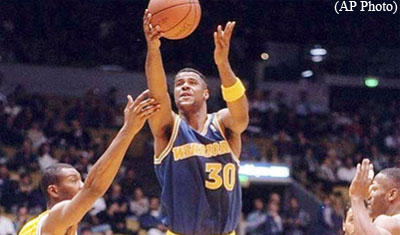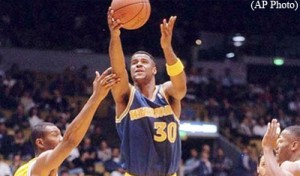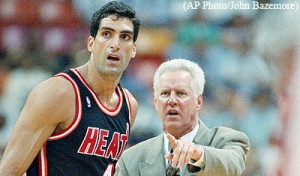
Part 2 – An analysis of why Syracuse players have seemingly disappointed in the NBA
In Part 1, I covered the “disappointing” history of former Orangemen in the NBA. So why exactly have we “disappointed?” There are a number of common theories, which I outline and discuss below.

Belief 1 – Syracuse’s 2-3 zone produces weak defensive players
The prevailing wisdom is that 2-3 zone is often better suited at hiding mediocre defensive players than a traditional man-to-man defense, so when Syracuse players reach the NBA, they’re exposed as lousy defenders. FALSE! Yes, several Syracuse players, including John Wallace, Hakim Warrick and Jonny Flynn have been defensive liabilities in the NBA, but those same guys were all below average defenders at Syracuse, so it seems fitting that they struggled in the NBA as well. Above average zone defenders such as Jason Hart, Etan Thomas and Rony Seikaly have all proved to be above average defenders in the NBA. And guys like Dion Waiters, Wes Johnson and Kris Joseph have all been lauded as being better-than-advertised man defenders thus far in their short careers. Why? Because defense is about athletic ability, desire and an understanding of where to be and when to be there. And any player missing one or all of those qualities is going to struggle to defend. So clearly playing the 2-3 zone in college doesn’t make a defender bad, nor does it make him good. With the exception of Andy Rautins, good zone defenders have made good man-to-man defenders, and lousy zone defenders make lousy man-to-man defenders.
» Take a look back at Part I of Nate Federman’s analysis
Belief 2 – It’s not the system we play but the type of players we recruit for our system
Boeheim has discussed at length the team’s desire to recruit players best suited to our system, in particular guys with length and quickness, capable of shutting off lanes on defense and then getting out in transition. So perhaps recruiting this type of player means that our recruits just aren’t well-suited for the NBA. FALSE! Yes, Syracuse does have a long history of recruiting long forwards who can score: Coleman, Owens, Wallace, Anthony, Warrick, Greene and Wes all fall into this category. But those respective players respective “failures” have little or nothing to do with their athletic abilities. Coleman and Wallace disappointed from a lack of effort, Owens from injuries, (a rail-thin) Warrick was always a suspect defender, Greene relied too much on his below-average outside shot, and Wes has struggled largely because of the system and team he was a part of. Over the years, Syracuse has recruited some players (like Pearl, Preston, Demetris and Stevie Thompson) whose physical abilities and games were better suited for college ball, and those guys struggled in the NBA, but not every recruit is expected to go pro or be successful, and there doesn’t seem to be any real correlation between the type of players we recruit who have been successful (Coleman, Seikaly, Douglas, Anthony, Thomas, Hart, etc.) and those who have disappointed (Flynn, Greene, Wallace, Moten, etc.). Simply put, nearly all of our recruits fit our system, but only some of them are suited for success on the next level (just like at pretty much every other college in the country).
Belief 3 – Syracuse is good at recruiting but lousy at developing players
The line of thinking here is we recruit guys who are talented enough to be effective college players but don’t develop their skills enough to be successful at the next level. FALSE! Quite the contrary actually. Syracuse has a long history of taking raw and/or unheralded players (like Seikaly, Thomas, Warrick, Watkins, Rautins, Dave Johnson, Joseph, McRae and Douglas, not to mention guys like Rick Jackson and Arinze Onuaku), slowly developing their skills over the course of their time with the Orange and turning them into NBA caliber players. Obviously we’ve had our share of misses, but what college hasn’t?
» More from Nate Federman: All your Knicks are belong to Syracuse
Conclusions
So if it’s not the system we run, or the types of players we recruit for that system, or how we develop the players once they get here, then why have so many Syracuse players “disappointed” in the NBA? Looking at the guys who have “disappointed,” there’s no one reason why they weren’t more successful. Some were lazy, others got injured, some didn’t have the athleticism necessary to be successful at the next level, others were drafted into lousy systems that didn’t mesh with their strengths.
Our “disappointments” also reveal something else—something interesting and unexpected, namely that despite the unremarkable careers of many of the former Orangemen drafted into the NBA, very few have actually been “legitimate disappointments.” Let me explain. In the past 25 years, there have been exactly two “sure-things” to suit up for Syracuse University: Derrick Coleman and Carmelo Anthony. The latter is in his 10th season in the NBA, a perennial all-star, and is widely considered to be one of the three best scorers alive. The former played for 15 seasons and routinely put up double figures in points and rebounds… and (despite what for the overwhelming majority of NBA players would be considered a remarkable career) is probably the greatest disappointment of any Syracuse basketball player, ever.

How could a 15-year veteran and former all-star be the greatest disappointment? Easy, the vast majority of our “disappointments” in the NBA were unheralded guys, who were developed at Syracuse and overachieved there. That over-achievement led to unfair expectations at the next level. Think of guys like Etan Thomas, Hakim Warrick, Damone Brown, Demetris Nichols, Darryl Watkins, Lawrence Moten, Andy Rautins, Kris Joseph, Jason Hart, Rony Seikaly, Dave Johnson, Wes Johnson and Sherman Douglas—they were all second- or third- or even fourth-tier recruits, guys, very few, if any, thought would develop into NBA players, and yet they all made the league. Regardless of what they did there, simply by getting to that point, they had already exceeded expectations and their careers should be considered nothing short of a success.
» More SU basketball: Five predictions for the upcoming season
Who are the disappointments? Coleman we’ve already covered. Billy Owens had an excellent start to his pro career before injuries derailed it. Stevie Thompson and Pearl Washington were highly touted recruits, but as good as they were in college, their games weren’t suited for the speed and size of the NBA and no matter where they went to college, they weren’t ever going to be. Leron Ellis was more interested in jazz than basketball. John Wallace could’ve been a very good player in the NBA but didn’t play defense. Jonny Flynn was always undersized, but had he been drafted into a better situation and/or not suffered a hip injury, one would’ve thought he should’ve at least been a very good second unit point guard in the NBA. Donte Greene didn’t stay at Syracuse long enough to develop into a great player, and the NBA is a tough place for a 19-year-old kid to be nurtured and tutored the way he needed to be. From that list, the only real disappointments (other than Owens, who again deserves an asterisk), were Coleman and Flynn, both guys who were expected to be quality pros, but fell well short, not just of their potential, but of reasonable expectations for them.
So while it’s easy to think SU has a long history of failure in the NBA, in reality, we’ve merely over-achieved in developing players in college. UCONN, under Calhoun, can make the same claim, and perhaps an even stronger one, developing NBA players at a rate similar to UNC, Duke, Kentucky, Kansas and UCLA, but with a fraction of the talent. The (aforementioned) “elite” schools have had close to four times as many McDonald’s All-Americans as Syracuse and UCONN over the past 25 years, and the aforementioned schools, not surprisingly, are also the best represented in the NBA over that time. And yes, while UCONN can (and should) make the claim that it’s been better at developing successful NBA players (with even fewer blue chip recruits) than Syracuse, UCONN has had the arguably the highest success rate of any college in the country at developing NBA pros (although the University of Washington may have something to say about that as of late). That’s not a knock on Syracuse, but rather a credit to UCONN. Syracuse has been in the top 15 of McDonald’s All-Americans and the top 15 of producing NBA players. Perhaps our success rate with our top-tier recruits (besides Carmelo Anthony) is less than stellar in the NBA, but the amount of unheralded players that we’ve turned into NBA caliber players, seems to make up for much of that.
Going forward, the future looks bright for Syracuse. Our recruiting has been as consistently good as it has been at any point in the history of Syracuse basketball. If the past is any indicator, the more top recruits we bring in, the more NBA players we’ll produce, and the higher the odds that former Orangemen continue to make a meaningful impact in the NBA. We may not be one of the elite schools, but we’ve managed to turn the often over-looked players into collegiate stars and solid pros. And hopefully we can get more of the ultra-elite elite recruits, because three out of the four we’ve had (Coleman, Wallace and Anthony) have helped lead us to the National Championship game.
For more Syracuse coverage, Like our Facebook page and follow us @TheJuiceOnline.
